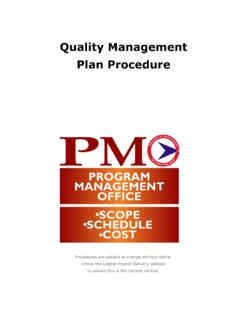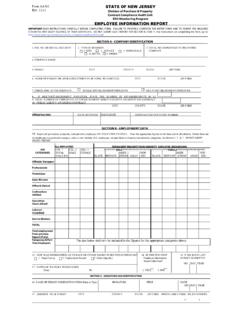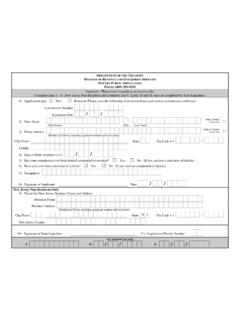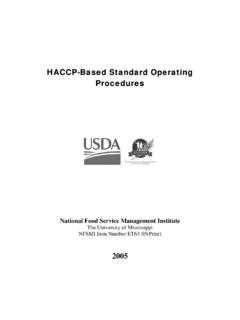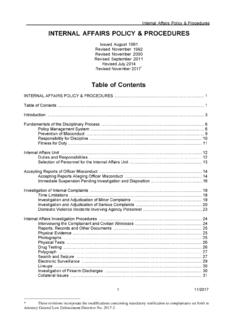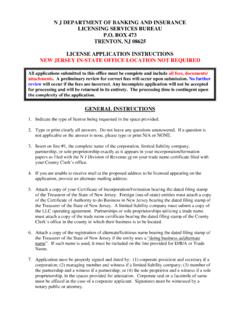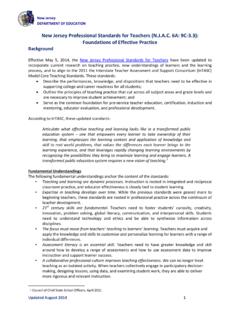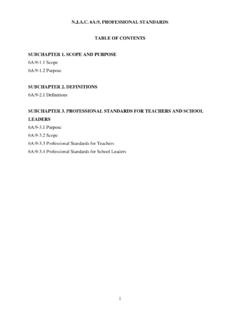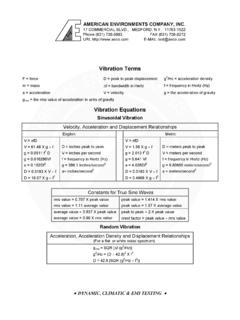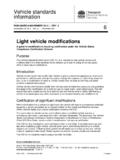Transcription of Fact Sheet on Tritium Exit Signs - New Jersey
1 fact Sheet on Tritium exit Signs New Jersey Department of Environmental Protection Bureau of Environmental Radiation Radioactive Materials Program Box 420 (Mail Code 25-01) Trenton, NJ 08625-0420 Tel. (609) 984-5462 Fax. (609) 633-2210 Website: This document uses much of the guidance from the Nuclear Regulatory Commission s (NRC) publication: NUREG 1556 Volume 16 Revision 2, Appendix G and is edited for Tritium exit Signs in New Jersey As a general licensee using a self-luminous exit sign , you must appoint an individual responsible for fulfilling the regulatory requirements listed in 7:28 Subchapter ( ). This Subchapter incorporates most of Chapter 10 of the Code of Federal Regulations Part 31 Section , which is commonly written: 10 CFR ( ). In general, these requirements are: You cannot remove the labeling or radioactive symbol on the sign . You cannot abandon a self-luminous exit sign . You must properly dispose of a self-luminous exit sign by transferring it to a manufacturer or radioactive waste broker specifically licensed by the NRC, NJDEP or another Agreement State.
2 Any lost, stolen or broken sign (s) must be reported to NJDEP. You cannot give away or sell the self-luminous exit sign to another individual, company, or institution unless the device is to remain in use at a particular location; for example in a transfer of ownership of a building. In this case, you are obligated to pass on a copy of the regulatory requirements to the new general licensee and you must report this transfer to the NJDEP. A company name change or change of address must be reported to the NJDEP. Further Detail: 1. What is a self-luminous exit sign ? A self-luminous exit sign is a non-electrical product that uses radioactive Tritium gas to produce light. Specifically, the Signs contain light sources that consist of glass tubes, internally coated with phosphor, and filled with Tritium gas. Tritium (H-3) is an isotope of hydrogen that emits low-energy beta radiation in the form of electrons. These electrons excite the phosphor, causing the glass tubes to continuously emit light.
3 A self-luminous sign is a generally licensed (GL) device because it contains radioactive material. A Self-Luminous exit sign is shown in the attached figure. Certain self-luminous, Tritium exit Signs can be possessed under 10 CFR Typical devices initially contain 25 curies of Tritium per sign . 2. Do I need to obtain or apply for a license to use a self-luminous exit sign ? No. Self-luminous exit Signs are generally licensed by the New Jersey Department of Environmental Protection (NJDEP). Any company, institution, or individual conducting business can use self-luminous exit Signs without a specific license from NJDEP. The companies, institutions, or individuals do not have to apply for a license; they are automatically considered "general licensees" of NJDEP and must follow the NJDEP requirements for use of the Signs . NJDEP maintains a database of owners and the locations of the self-luminous exit Signs . The distributors of self-luminous exit Signs are, however, specifically licensed by NJDEP.
4 They provide information to NJDEP to maintain the database of self-luminous exit Signs owners. 3. What is a 10 CFR "general licensee"? Any company, institution, or person conducting business who uses, stores, or possesses a self-luminous exit sign acquired in an authorized manner is a general licensee. 4. What are the reporting obligations of a general licensee for Tritium exit Signs ? As a general licensee you are required to make certain reports. These reports are summarized in the following table. All reports are to be sent to: Bureau of Environmental Radiation, NJDEP PO Box 420 (Mail Code 25-01) Trenton, NJ 08625-0420 Type of Report Contents of Report Frequency Disposal or transfer Identification of device by manufacturer's (or initial transferor's) name, model number, and serial number; name, address, and license number of recipient; and date of transfer. Within 30 days of transfer, or disposal. Change of ownership (where device remains in use at a particular location) Manufacturer's (or initial transferor's) name, model number, and serial number; name and address of the transferee; and name, title, and phone number of the responsible individual of the transferee.
5 Within 30 days of transfer. Damaged device Brief description of the event and remedial actions taken. Within 30 days of occurrence. Licensee name change New name or mailing address of general licensee. Within 30 days of occurrence. Incidents of lost or stolen devices The following information: a) Description of the radioactive material; b) Description of the circumstances under which the loss or theft occurred; c) Disposition of the radioactive material; d) Radiation exposure to individuals; e) Actions taken to recover the material; f) Actions taken to prevent recurrence. Telephone report within 30 days of occurrence; written report within 30 days of the telephone report. 5. How do I identify a self-luminous exit sign ? All Self-luminous exit Signs are required to have a permanent label affixed to the sign that identifies it as containing radioactive material. The label will contain the words "Caution - Radioactive Material" and may also include the radiation symbol, which is illustrated in the attached figure.
6 In addition, the label will include the name of the manufacturer (or initial transferor), the product model number, the serial number, and the quantity of Tritium contained. 6. How can I tell if it is working? Because self-luminous exit Signs will not appear to be lit in ambient light conditions, they must be viewed in darkness to evaluate their performance. When viewed in the dark, all letters should be visible. If the letters are clearly legible and uniformly lit, the sign is functioning properly If the luminance appears to be uniformly low, check the UL label to determine the expiration date of the sign . If the sign has passed its expiration date, it no longer meets the luminance requirements of the applicable fire or building code. Contact the manufacturer for replacement and disposal information. If any letter(s) or part(s) of letters are not lit when viewed in the dark, the sign is not functioning properly. This may mean that the sign has been damaged and that one or more of the internal light sources has been damaged.
7 In this instance, contact the manufacturer immediately for return instructions. 7. What should I do if a sign is broken or damaged? Most Signs that are broken do not cause a release of Tritium . If a sign is excessively damaged, the Tritium gas could be released and would dilute rapidly in the air. Keep in mind that for this to occur, the outer frame and inner protective housing would also have to be damaged. The area should be evacuated and ventilated to avoid unnecessary exposure to the radioactive material. The material does not pose any immediate health hazard to workers at the location or members of the public. However, the sign would be expected to have relatively high levels of Tritium on it and should be properly handled. Do not move the sign into other areas to avoid spreading contamination prior to disposal. Contact the manufacturer for directions on proper handling of the damaged sign , as well as proper shipping and disposal.
8 If you do not know who the manufacturer is, carefully look on the sign itself for the name and phone number of the manufacturer. If you still cannot identify a manufacturer, call NJDEP to request assistance in dealing with the broken sign . Typically, manufacturers will advise a procedure such as the following: Wear rubber gloves and eye protection since you may come in contact with broken glass and/or radioactive material. Wipe the entire surface of the sign with a paper towel. Wrap the sign , paper towel, and gloves in a plastic bag ( , garbage bag) and tape it closed. Wash your hands with soap and water. Wrap the sign a second time in a plastic bag ( , garbage bag) and tape it closed. Wash your hands with soap and water. Place each sign in a sturdy carton. Use filler materials to assure a tight, rattle-free fit. Tape the seal flaps and seams. Label the carton: "RADIOACTIVE". Place this package into a second sturdy cardboard carton and include a piece of paper with the following words: "This package conforms to the conditions and limitations specified in 49 CFR for radioactive material, excepted package-instruments or articles, UN2910.
9 " Use filler materials to assure a tight fit. Tape the seal flaps and seams. DO NOT label this outer carton "RADIOACTIVE." Before shipping, contact the manufacturer whose name appeared on the sign label. Submit a report to NJDEP (see the table of reporting requirements in Question 4). 8. Can broken Signs contaminate buildings and require cleanup? Yes. If the sign is severely damaged and mishandled, the contamination can be spread throughout a room, or building - wherever the sign traveled. If contamination occurs, appropriate cleanup is required by a person specifically authorized by NJDEP for this activity. Keep in mind that for this to occur, the outer frame and inner protective housing would have to be damaged and the sign mishandled. To avoid spreading contamination, follow the instructions in the previous question. 9. Do I need a license to sell self-luminous exit Signs ? It depends on whether or not the exit Signs are stocked for sale.
10 If you intend to maintain an inventory of exit Signs for sale to customers, you must obtain a specific NJDEP license for distribution. You do not need a license if you sell Signs to individual customers and obtain the Signs through a specifically licensed distributor. You must provide this distributor with the customer's name, address, and the name of the responsible individual (see Question 4) prior to initial shipment from the distributor. 10. Can I throw a self-luminous exit sign in the trash? No. It is unlawful to abandon or dispose of self-luminous exit Signs except by transfer to a manufacturer or other person specifically licensed by NRC or the NJDEP. Most manufacturers will accept the return of any self-luminous exit Signs . It is important that these Signs be properly disposed of and that they not be abandoned because they can end up damaged. They can also end up in the hands of individuals who do not know that they are radioactive and may inadvertently contaminate themselves.
